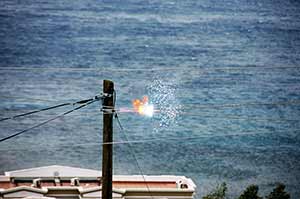The apocalypse is a common theme in literature and TV, some of the most disturbing include The Death of Grass by John Christopher (in which all of the worlds plant food dies) and Alas Babylon by Pat Frank, which depicts a nuclear war. In both cases human beings survive, but civilization as we know it has ended.
If our civilization ended in a similar fashion tomorrow, what could we do to get things back on track again? Carl Sagan once warned that we are living in a society increasingly reliant on science and technology, despite almost no one knowing anything about how it works. Here’s how, in brief, we could bring power back to the people after an apocalypse:
-
Re-discover electromagnetism (in the library)
The Europeans knew about the ‘magical’ effects of electricity and magnetism for centuries before they understood it. They used it for trivial things, including tricks at children’s parties.
For example, society had batteries without really understanding how they worked. It was the discovery of electromagnetism and its equations, by Michael Faraday and James Maxwell, which changed the world forever. Faraday and Maxwell understood that an electrical force generates magnetism, and that a magnetic force, in turn, generates electricity. This simple reciprocal relationship is the foundation on which the modern world today is ran. For example, you can generate as much electricity as you like by spinning a magnet inside a wire coil, or vice versa.
A strong magnet alongside a wire can also generate a ‘motor effect’ – the motors that drive much of our industrial machinery operate in this way.
-
Re-invent the windmill and the waterwheel: crafting
 food, architectural steel, and clothing
food, architectural steel, and clothing
The Romans invented terribly inefficient watermills in antiquity. They are the very first known application of gearing to transfer power; the earliest roots of mechanization. The windmill, the earliest harnessing of wind power, works in a not-too-dissimilar way to the watermill, with the advantage that its beneficiaries don’t have to be located near a water source.
The earliest watermills operated with right-angle gears and the windmills with cam mechanisms. These gears and mechanisms were fundamental in the pressing of olives, linseed and oils, wood—boring and glass polishing, and the pounding of the very first architectural steel into shape. In other words, everything society needed before the great industrial leap.
Only they didn’t have the advantage that a civilization looking to re-boot has. In our case, we could retro-fit these windmills and waterwheels with electric motors.
-
The knock on effect: re-appropriating more and improved architectural steel
With the increased efficiency of the motor-led watermills and windmills, humanity will have more time to up its game. To make the mills even moreefficient a good grasp of aerodynamics is needed, to get the most out of the energy-conversions of the wind and water entering the mills. Many of these inventions will only be possible with greater architectural steel production – something the motor-led mills would be increasingly able of producing. A Pelton turbineis a watermill made out of metallic scoops. It would be a great ‘leg-up’ on the journey back to civilization.
-
Re-discovering steam
We talk about the age of steam like it is over. In reality, about 80 per cent of all the electricity we use today is generated from steam power, whether it is in a coal plant or a nuclear reactor.
Producing heat is easy (try it right now: rub your hands together), but turning heat into power is tricky. Well, that’s where steam comes in. As our civilization gets to its feet again, we can again modify our mills into steampowered mills. Steam is very efficient and produces lots of energy – again, the steam revolution will be our ticket into a new modern age.
-
Re-establishing an AC distribution network
One of the biggest things we take for granted is electricity. Mainly, how we don’t have to hug a power plant to benefit from it. In order to truly give power to the people, electricity needs to be portable. A rapidly cycling alternating current (‘AC’) is what we would need to do it.
Electricity generated from an AC is generated in the coil swings from positive to negative and back again, so the current it drives also reverses direction, moving back and forth in the wire like a rapid tide. The beauty of AC is that it allows the voltage to be moved up and down with the use of transformers. Transformers are essentially just large coils of wire positioned alongside each other. They tone down wasteful high electrical currents – which are also dangerous – and help to transport electricity over long distances.
With the establishment of an AC distribution network, civilization should find itself in a position similar to early twentieth century Europe. With easily accessible electricity to fuel heat, lighting, and computers, any survivors of the apocalypse should comfortably be able to say they’ve “made it”.






